Fort Yellowstone
- Deborah Kade
- Jun 4, 2019
- 8 min read
Updated: Oct 13, 2019
May 16, 2019
For the decade after Yellowstone National Park was established in 1872, the park was under serious threat from those who would exploit, rather than protect, its resources. Poachers killed animals. Souvenir hunters broke large pieces off the geysers and hot springs. Developers set up camps for tourists near hot springs, along with bath and laundry facilities in the hot springs. As a result, civilian superintendents were hired to preserve and protect the land. Their experiences and intentions varied. They were underfunded and understaffed. Congress received word the park was in trouble, but legislators refused to appropriate funds the the park's administration in 1886.
Yellowstone National Park turned the the U.S. Army in 1886 for help. Men from Company M, First United States Cavalry, Fort Custer, Montana Territory came to Yellowstone under the command of Captain Moses Harris. This would be the beginning of a 32 year military presence in the park.
In the beginning, soldiers lived in temporary frame buildings at Camp Sheridan at the foot of the Mammoth Hot Springs Terraces.

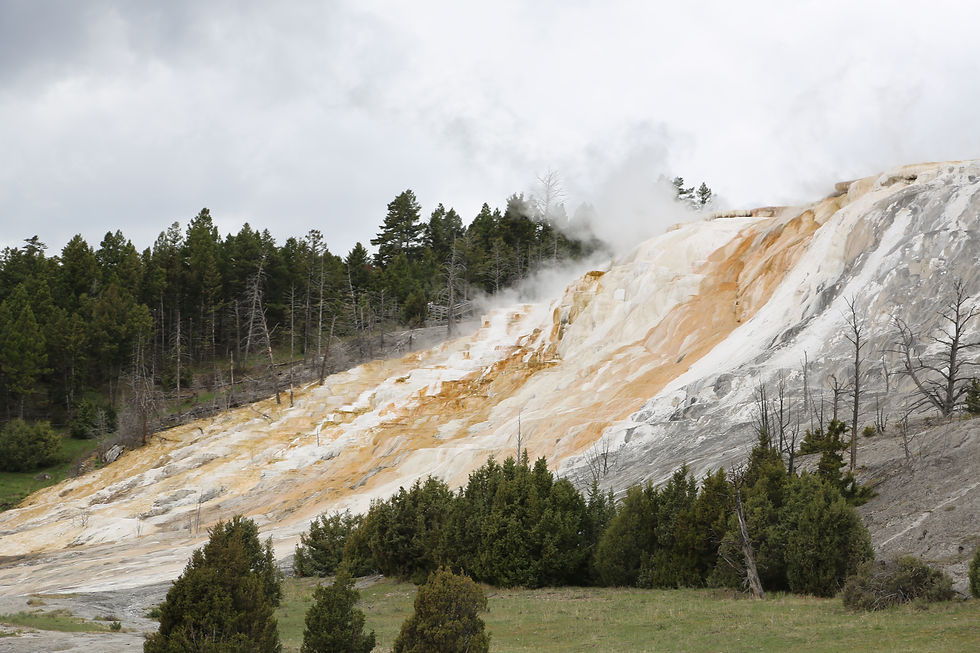

After five harsh and extremely cold winters, the Army realized there was no end in sight to this assignment. Therefore, in 1890, Congress appropriated $50,000 for a permanent post.
The name of the street is Officer's Row

Michael and I took the .6 mile (1km) walking tour of the Fort Yellowstone National Historic Landmark.


The tour started at the Albright Visitor Center.
This building, in 1909, was the bachelor officers' quarters. This building had an officer's mess or club, kitchen, sitting room and apartments for six single officers.


Michael and I spent quite some time at the Visitor's Center. They had some wonderful exhibits. There is so much information!!




Do you know the difference between a grizzly bear and a black bear?


Make sure you are aware and read all the warning signs. They may save your life!


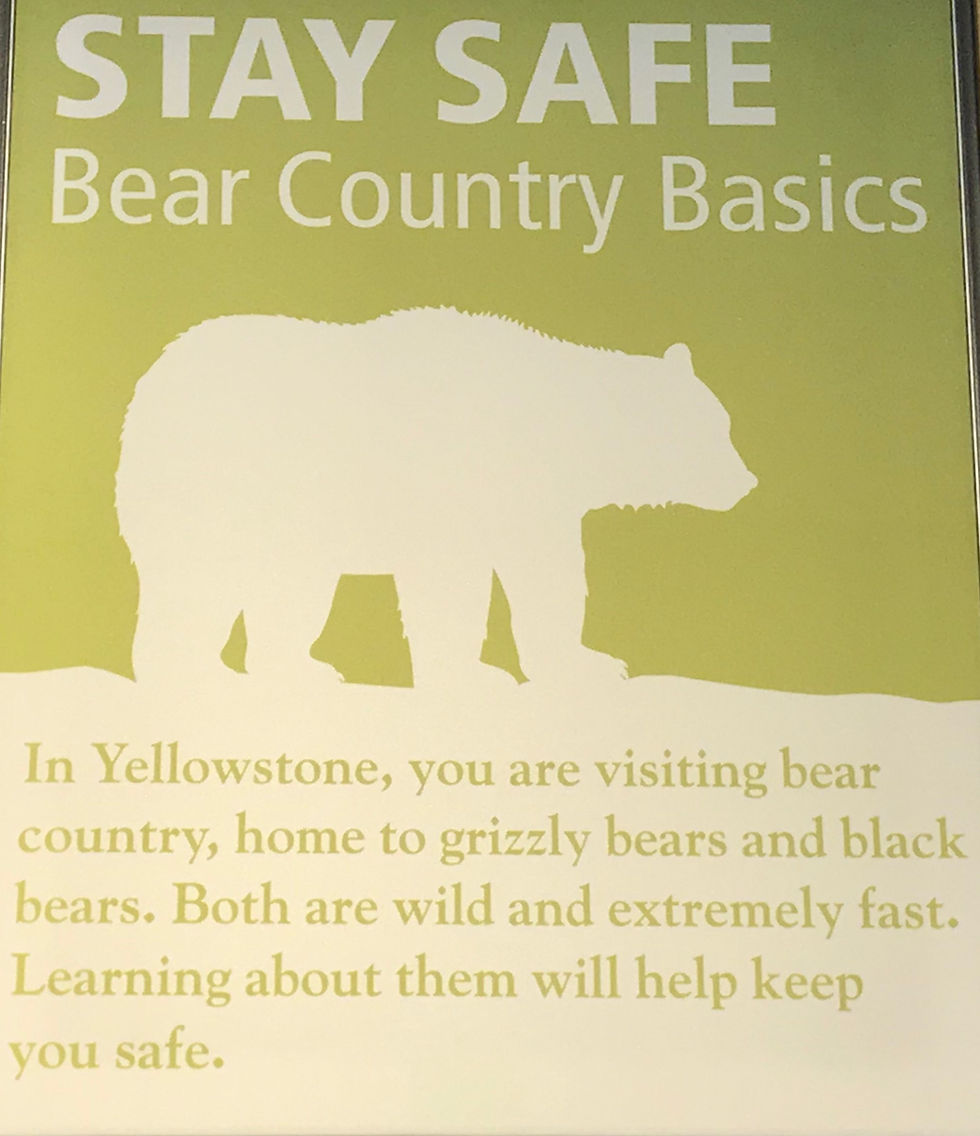
Yes, they sell bear spray!

Whose tracks are these?


Many display cases.


Most of the buildings constructed during the Army era are still standing and used by the National Park Service as park headquarters.
Many of the interiors have been modernized, while the exteriors have been maintained and/or restored.
At present, many buildings in the Fort Yellowstone Historic District are employee residences and are not open to the public.
The first buildings of Fort Yellowstone, at the far end of the street from the Albright Visitors Center, were finished by late 1891: two duplex officers' quarters, a guardhouse, and a headquarters building on the front row; a barracks on the second row; a stables on the third row; and two non-commissioned officers' quarters in the final row. An almost identical set of buildings was finished in 1897 to house a second troop.
In 1909, Scottish stonemasons began constructing seven large sandstone buildings using standard military plans in the Colonial Revival style. The buildings represent the Army's attempt to live up to a substantial commitment and to provide a model post for visitors. The stone for these buildings was obtained from a quarry between the Gardner River and the Mammoth Campground.

Field Officer's Quarters 1909
The residence of the acting superintendent/post commander. Today it houses Yellowstone's superintendent.

Double Officers' Quarters 1891 and 1897

I wonder if they still use the chimneys.

The two farthest down were among the first buildings built in Fort Yellowstone.

Post Headquarters 1891
Office for the post commander/acting superintendent, the post adjutant and the sergeant major.

Guardhouse 1891
The guardhouse could hold 15 prisoners and 10 guards. Every visitor had to check in at the building after entering the park from Gardiner, Montana. A new guard house was built in 1911.
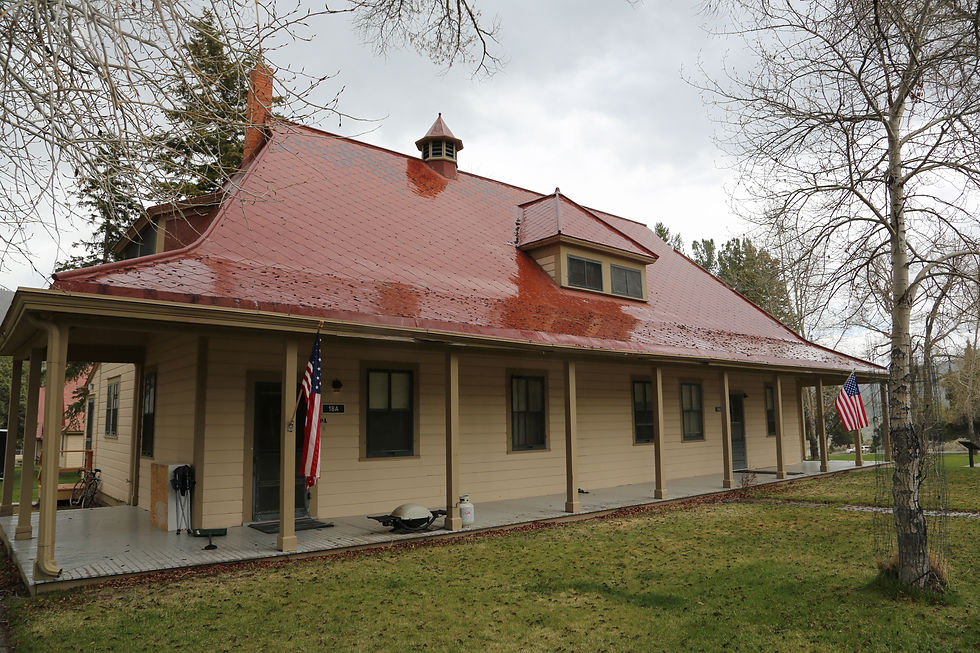
Protecting Yellowstone's wildlife and natural wonders were the primary aim of the Army. An important part of this duty was managing the growing visitation to the park and watching for "shady characters".
Park roads were once aligned so that the guardhouse controlled traffic into Yellowstone from the north. Here, soldiers contacted each party and entered the name of the driver; passengers; and type of rig into a large ledger. Guns not held at the guardhouse were sealed on the spot. They were checked at each outpost enroute, where soldiers certified on a form that the seal remained intact. Before visitors left the park, the form was scrutinized at an exit station.

View of the back of the homes on Officer's Row.

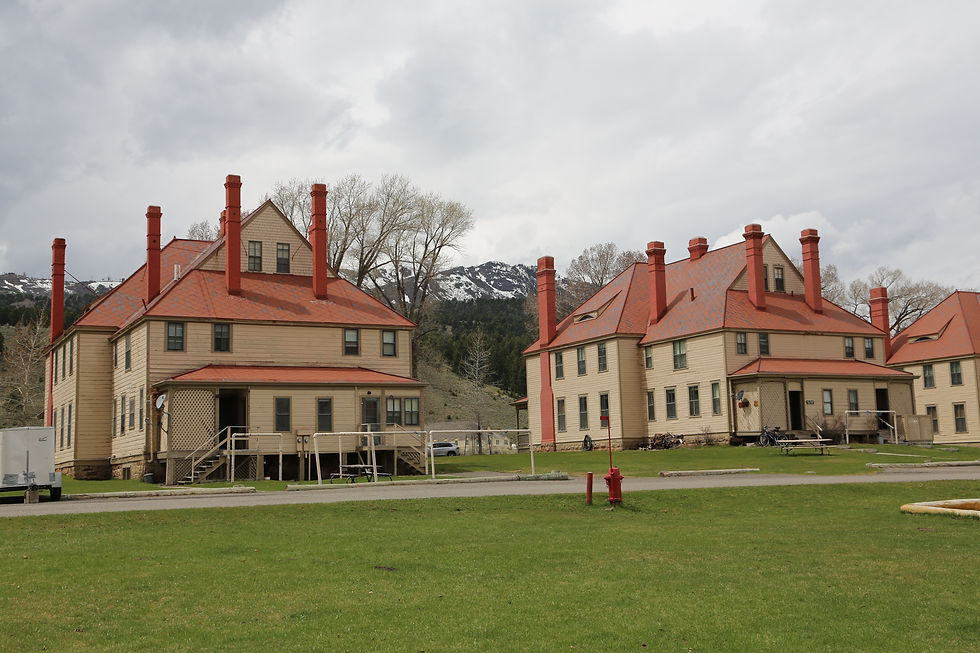

The Christmas tree still had lights.


Foreground: Commissary Storehouse 1891
Troops acquired their rations here. Both commissioned and non-commissioned officer's families were authorized to buy groceries here. Now used as a residence.
Middle: Quartermaster Storehouse 1891
This building was used to store supplies such as clothing, blankets, and equipment. Now used as a residence.
Next: Granary 1891
This building was used to store grain for horses and is now a residence.
Last building: New Guardhouse 1910
This building still serves as the park jail.
Interesting to note the attached ladders for evacuation.

So many roads in the park are still closed.

Chapel 1913
The chapel was the last existing building completed during the Army era. Built of native stone with a slate roof and oak furnishings, it is still used today and is the best preserved building at the fort - inside and out.
The chapel added a finishing touch to the fort and was considered by far its most beautiful structure. The community held religious services in the troop mess hall, the post exchange, or in a private residence until the chapel was built. In1914, Katherine Piercy Edmunds and Captain Albert Ady King became the first couple to be married here.
In the decades since, the chapel continues to serve the community. Thoughtful design has given it a timeless splendor that complements its wilderness setting.



Family and friends know we light candles and say prayers for you when we come upon a church. It is a travel tradition with us. Well, we said prayers outside. The scenery was breathtaking so it was just as special.

Hospital Annex 1913
Quarters for personnel assigned to hospital duty. It is now a residence.

Hospital Steward's Quarters 1894
Currently used as a residence.

New Guardhouse 1910
This building still serves as the park jail.

The buildings of Fort Yellowstone are a testament to the long history of our first national park and of the important role the Army played in preserving it for the future. They remind us that the resources we find within Yellowstone's boundaries are not only natural ones, but cultural as well. Our interactions with this wilderness continue to shape our idea of what a national park should be, just as they did during the days of Fort Yellowstone.
Some soldiers considered Yellowstone to be a good duty station. The men of the "snowshoe cavalry" liked their rough life in the remote recesses of the mountains and some applied freely for service at these outposts. The life was demanding and often isolated, rugged and dangerous. This was very different from what most of them had known in other postings. Fort Yellowstone's facilities were better than most and discipline was more relaxed, especially in the field.
Most of the recruits came from dusty, hot duty in the Southwest or western plains. Yellowstone's weather was quite a change and a relief in many ways. Some had never seen mountains or snow and they much to learn.
For some of the enlisted men, the change was too much. In 1907-1908, there were 67 desertions, mostly tied to the isolation of Fort Yellowstone. Many soldiers viewed the combination of civil and military duties with disfavor.
Ten cavalry units served at Fort Yellowstone during the 30 years- troops from the First, Third, Fourth, Fifth, Sixth, Seventh, Eighth. Eleventh, and Thirteenth cavalries, and an experimental unit of men selected for their particular skills in mountain living.
Until passage of the Yellowstone National Park Protection Act, also called the Lacey Act, in 1894, the only provision for law enforcement was the Organic Act that established the park and this only allowed for the expulsion of trespassers. Any poaches or tourists caught committing a serious infraction were marched to Fort Yellowstone afoot escorted by mounted soldiers. Often, their possessions were left at a different entrance to the park so that the miscreant had to travel around the outside of the park to retrieve his belongings.
Cavalry Barracks 1891 and 1897
The barracks to the south was built in 1891 and razed in the 1980's. Both buildings were built to hold 60 men. The remaining building now contains offices.

Stables


In 1910, at the height of the Army's presence in Yellowstone, there were 324 soldiers here- plus some families and numerous civilian employees. These troops staffed Fort Yellowstone and the park's outposts. From these outposts, the cavalry patrolled the park by horse in summer and on skis during winter, stopping at patrol cabins along the way.
Tourist season provided company for the officers, whom entertained visitors and friends and house guests. Carriage rides and picnics took place during the warm months, and sleigh rides and ice skating were favorite pastimes during the cold months.
There was much socializing, particularly among the officers' families; lunches and dinners together were common. With domestic help, these social events weren't a problem for the high ranking officers, but a lot of work for the wives of lower ranking officers whom could not afford staff. The isolation of the fort was softened in the summer by this busy social schedule.
Children usually went to school at the fort. Teachers were found among the soldier ranks when possible. Otherwise, families with children paid the expenses of a civilian teacher. In 1910, when no teacher could be found, the children were sent to relatives and friends to attend school.
One of the challenges of fort life was keeping supplies on hand. Clothing and household items were usually ordered by catalog and some things were purchased through the PX (Post Exchange). Whittaker's store near the Mammoth Hotel had novelties and many smaller items, and the Post Office had sundries as well.
Enlisted men spent their free time in a number of ways. Most weren't married. The Army discouraged marriage among enlisted men and seldom provided allowances or rations for their families. So, they had plenty of free time and few ways to spend it. They could visit the gym or bowling alley or play cards.
As soon as the first heavy snow fell, the entire community donned skis. Some sidewalks were kept shoveled, but anyone wishing to go elsewhere had to skis. The porches of the officers' quarters were lined with graduated collections of skis - from long to medium, short to very short- and the officers bought new skis regularly for their children, just as they did new shoes.

Troop Barracks
At Fort Yellowstone, a soldier lived with his company in the Troop Barracks.
A typical day began at 5:30 a.m. at the stables where the horses were fed and groomed. Activities could also include guard duty, training, and work details (also known as Fatigue). Afternoons could be spent practicing on the firing range, participating in ceremonies and demonstrations for visiting dignitaries or patrolling Mammoth Hot Springs terraces to prevent visitors from chipping away souvenirs.

Post Exchange
At the Post Exchange, a soldier with free time could spend it in the gymnasium or bowling alley, or could play cards and drink beer. There may also have been a billiards table. Movies were shown once a week. The building was informally known (and still is) as the Canteen, probably due to the Army sanctioned beverages that were available.




Bet these boot scrapers come in handy in the winter when you want to clean the boots of snow.

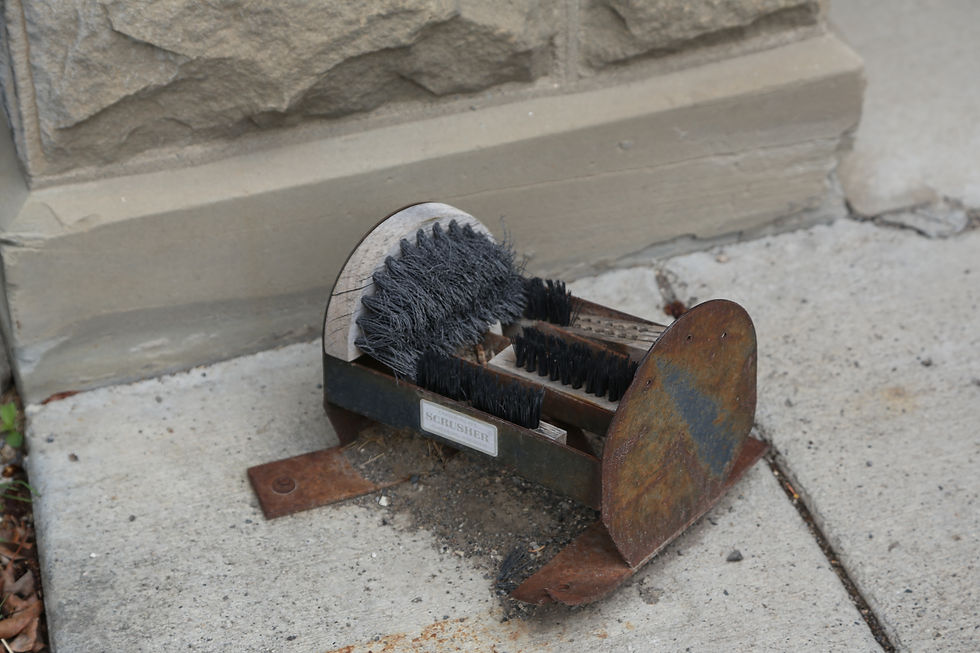

Mammoth Clinic

United States Post Office Yellowstone National Park Wyoming

When Alden Roseborough accepted the Mail Carrier's position in 1895, a long and rugged road awaited. The route, a 100 mile round trip, took him from Mammoth Hot Springs through remote northern Yellowstone National Park to Cooke City, an isolated mining town in the Absaroka Mountains. He carried precious threads of communication between Cooke City and the outside world.
To facilitate regular journeys, Mr. Roseborough leased two cabins along the route. He also erected this cabin and became its first occupant. The dwelling served as an employee residence for more than a century.



In 1916, when Congress created the National Park Service, the Army turned Fort Yellowstone over to the new agency. Local resistance made this transition difficult, and the Army returned in 1917. The park was fully under National Park Service control in 1918, and the Army departed. The fort has served the park well, both as administrative headquarters and as a constant reminder of the debt the nation owes the officers and enlisted men of the United States Army for protecting and preserving Yellowstone National Park for future generations.
Children would love visiting Yellowstone. So many fun games to play....
Name that bird

What is running across the street?


Whose scat is that? (scat is used in reference to wild animal droppings only. Animal scat in the wild is important in identifying and tracking particular wild animals.)You always need to watch your step when walking through Yellowstone.

Whom shed that fur? Looks soft but are there fleas hiding within?






Comments